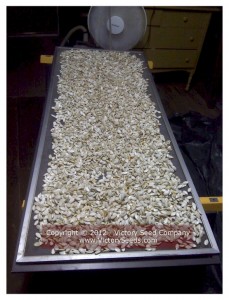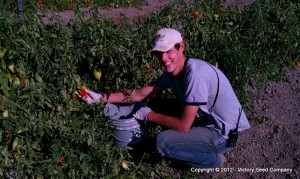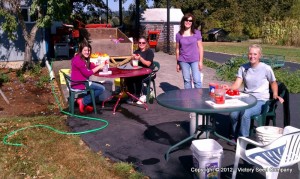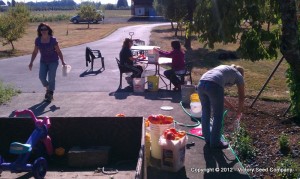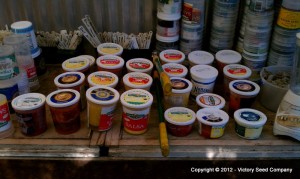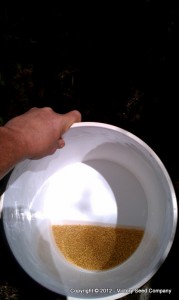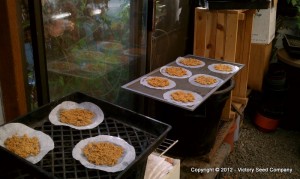2012 is winding down and I wanted to get one last blog post up here to prove that I haven’t forgotten how. I have no way of filling in all that has been going on around here since my last update. The summary is that we have been busy getting ready for the upcoming gardening season and all of the little details that it entails. I have been working on finishing up getting the “New for 2013” varieties listed on the site. We still have odds and ends to finish cleaning, testing and getting them ready.
Here is a snapshot of my day . . . I got to bed at 3:00 a.m., up at 8:00 and out to the office by 8:30. John got here at 9:00 and worked on finishing up getting seeds collected out of our ‘Boston Marrow‘ squash harvest. They look good so assuming that once they are dried, cleaned and test good, they will be another new variety for this season.
In between the normal daily tasks that interrupt a good workflow, I worked on cleaning up our mailing list. Man, I had forgotten how tedious that job is. ![]() It has been a couple of years since we mailed out a catalog so it took much of the day to finish a first pass.
It has been a couple of years since we mailed out a catalog so it took much of the day to finish a first pass.
Other little odds and ends that I got crammed into the day . . . . read through four “new” seed catalogs from 1929 that came in the mail today. They included a Berry Seed, Maule’s, Earl May, and a Gurney. I also received a 1944 “Vaughan’s Gardening Illustrated” which was an interesting edition for a couple of reasons. Firstly it is a WWII Victory Gardening edition and secondly it contains a full page company history / biography / obituary / for Leonard Holden Vaughan. For a seed geek like me, great information. I will eventually get the information shared at SaveSeeds.org.
Old seed catalogs are not simply a diversion. They are serious tools for researching the histories and pedigrees of the old varieties that we work to preserve and as a byproduct, I get to learn about the histories of the old seed companies as well. Now for a plug – If you ever run across old seed catalogs while cleaning, please don’t throw them out. Keep us in mind.
Let’s see . . . what else happened?!?! While working on book keeping tasks, I like to multitask. Today I listened to a documentary called “Farmageddon.” If you are interested in the survival of the “real food,” organic, local food movement, I would recommend taking the time to watch it.
After everyone left for the day, I went out to lock up the gate and noticed that some fence wires were down. Thankfully it wasn’t raining so I went for a walk up the property line. As Murphy’s law would have it, I had to walk nearly to the far end of the farm before I found the break. Got it patched up, headed in for supper with the family, visited for a while and on the way back out to the office, stoked up the furnace and then stopped at the cabin to water everything in germ test. It is now midnight and I still have to get my part of the order fulfillment process done so the crew won’t be held up in the morning. If I have time, I have a bunch of donations to get ready to send out. I am going to try and get to bed before 3:00. A day in the life ![]()
